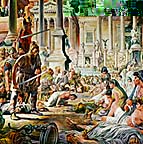 "On December 9, 536 AD, Byzantine Count Belisarius entered Rome through the Asinarian Gate at the head of 5,000 troops. At the same time, 4,000 Ostrogoths left the city through the Flaminian Gate and headed north to Ravenna, the capital of their Italian kingdom. For the first time since 476, when the Germanic king, Odoacer, had deposed the last Western Roman emperor and crowned himself 'King of the Romans,' the city of Rome was once more part of the Roman empire--albeit an empire whose capital had shifted east to Constantinople."
"On December 9, 536 AD, Byzantine Count Belisarius entered Rome through the Asinarian Gate at the head of 5,000 troops. At the same time, 4,000 Ostrogoths left the city through the Flaminian Gate and headed north to Ravenna, the capital of their Italian kingdom. For the first time since 476, when the Germanic king, Odoacer, had deposed the last Western Roman emperor and crowned himself 'King of the Romans,' the city of Rome was once more part of the Roman empire--albeit an empire whose capital had shifted east to Constantinople."
"Centuries of warfare against mounted enemies such as the Goths, Huns and Persians, however, had changed the makeup of the Roman army. By the 6th century ad, the army consisted primarily of a cavalry force of armored lancers, or cabalarii, wearing body armor and capable of handling a bow from horseback. Garrison duties and defensive positions were held by two types of infantry: lightly armed archers and heavily armed soldiers in mail jackets who fought with sword, ax and spear."
"For Belisarius' small army, the struggle for Rome required tactics that involved horsemen striking swiftly from walled cities much as the knights of a later age would do. The campaign would amount to a series of sieges against and sorties from fortified places rather than being fought in the field as early Roman wars had been."
No comments:
Post a Comment